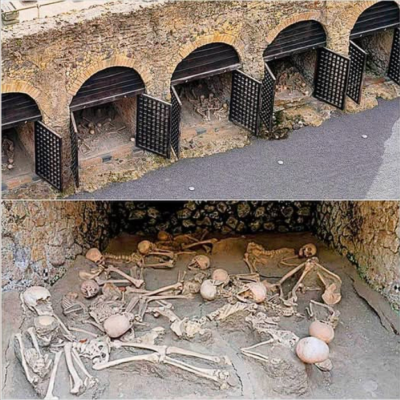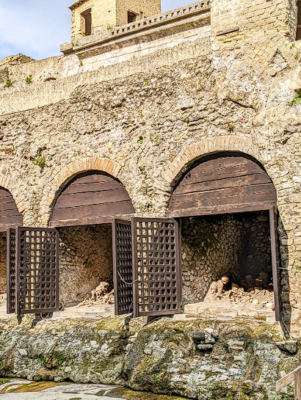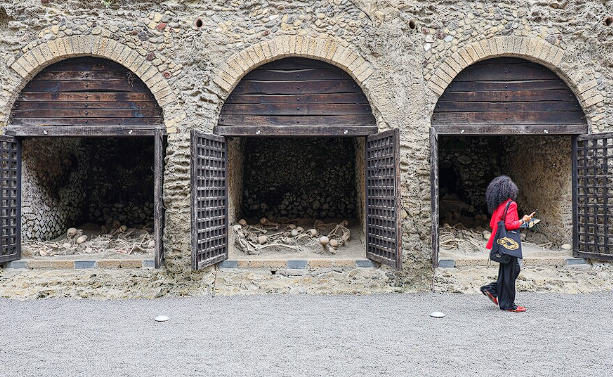Herculaneum, an ancient Roman city located near modern-day Naples, shares a tragic fate with the more famous Pompeii. Destroyed by the catastrophic eruption of Mount Vesuvius in 79 AD, Herculaneum was buried under thick layers of volcanic ash and mud, preserving much of its architecture, frescoes, and even organic materials in remarkable detail. Recently, the site’s beachfront area, where many perished while attempting to escape, has reopened to the public, offering an even deeper understanding of this lost civilization.
The History of Herculaneum
A Prosperous Roman City
Herculaneum was a thriving Roman town, smaller yet wealthier than Pompeii. Known for its luxurious villas, intricate mosaics, and well-planned streets, the city was a prime example of Roman architectural excellence. Situated along the Bay of Naples, it was a popular retreat for the elite, boasting seaside views and sophisticated urban planning.
The Eruption of Mount Vesuvius
In 79 AD, Mount Vesuvius erupted violently, unleashing clouds of volcanic ash, gas, and molten rock. Unlike Pompeii, which was covered in fine ash, Herculaneum was buried under pyroclastic surges—a mix of superheated gas and volcanic material—that preserved buildings, furniture, and even food items with astonishing clarity. The rapid burial helped protect much of the city’s remains from decay, offering a unique archaeological record of daily Roman life.

The Rediscovery and Excavation of Herculaneum
Early Excavations
Herculaneum was first rediscovered in the early 18th century when workers accidentally unearthed ancient remains while digging a well. Unlike Pompeii, which was exposed through traditional excavation, much of Herculaneum remains buried under modern structures. Despite these challenges, archaeologists have uncovered stunningly preserved buildings, including homes, shops, and public spaces.
The Beachfront Skeletons
One of the most haunting discoveries in Herculaneum is the collection of skeletal remains found in the city’s ancient waterfront chambers. When the eruption occurred, many residents fled toward the sea, hoping to escape. Tragically, they were overwhelmed by the intense heat and volcanic gases before they could reach safety. Their remains, now displayed in the newly reopened area, serve as a chilling reminder of the disaster’s impact.

What Makes Herculaneum Unique?
Remarkable Preservation
Due to the way Herculaneum was buried, organic materials such as wooden furniture, food, and even scrolls from the Villa of the Papyri have survived. This level of preservation provides archaeologists with an extraordinary look into Roman daily life, from household items to cooking techniques.
Art and Architecture
The city is filled with beautifully preserved frescoes, intricate mosaics, and grand structures. The House of Neptune and Amphitrite, for example, showcases a stunning mosaic of the sea god Neptune alongside his wife Amphitrite, reflecting the city’s artistic richness. Unlike Pompeii, where many buildings collapsed under the weight of volcanic ash, Herculaneum’s multi-story homes remain standing, giving visitors a more immersive experience.

Visiting Herculaneum Today
The Reopened Beachfront Area
The recent reopening of Herculaneum’s waterfront chambers allows visitors to step closer to history. Seeing the skeletal remains of those who perished in their desperate attempt to escape is a sobering yet essential part of understanding the human side of this tragedy.
Key Highlights of the Site
- The House of the Wooden Partition, showcasing intact wooden structures that have survived for nearly 2,000 years.
- The Thermopolium, an ancient Roman fast-food shop, where visitors can still see preserved food containers.
- The Bath Complex, revealing the advanced engineering of Roman heating and plumbing systems.
Conclusion
Herculaneum is a must-visit destination for history enthusiasts and travelers alike. While often overshadowed by Pompeii, it offers an unparalleled look into Roman life with its incredibly preserved structures and artifacts. The recent reopening of the beachfront area adds another layer of depth to the experience, making it an even more compelling site for those seeking to connect with the past.

CÁC TIN KHÁC
Mary Walton: The Forgotten Inventor Who Helped Clean Up America’s Cities
Tomb of Queen Nefertari in the Valley of the Queens, Egypt
Discover the Hypostyle Hall of the Temple of Hathor at Dendera
Venus de Losange: Unveiling the Mystery of a 20,000-Year-Old Paleolithic Icon